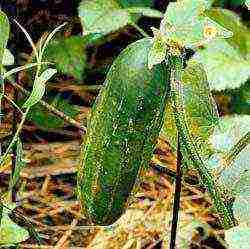Svetlana Lovygina
Research work "Conditions for growing green onions"
Introduction
Why did I decide to find out under what onion grows better in conditions?
Winter is on the street. There is snow all around, severe frost, little sunshine. In winter, many children and adults often get colds. We often have to hear: "Eat more vitamins"... How to replenish your body with vitamins? It turns out that the easiest way is to eat green onions.
In our kindergarten, every winter and spring we organize a vegetable garden on the windowsill - grow green onions... Children put soil in special containers, plant bulbs, take care of them. And after a while, the mini-garden pleases us with bright green feathers Luke... With special pride, we cut feathers and take them to the kitchen, where the chef adds them to various dishes - soups, salads. We believe that our work benefits all the children of our kindergarten.
During cultivation and observing the growth Luke, the guys and I came to the conclusion that for his good growth, a number of conditions, this is soil, water, heat, light.
Is it possible grow onions without soil? How will it develop in the absence of, for example, light or water? I decided to carry out a series of experiments.
The purpose of my research: the influence of different conditions for the process of growing green onions.
Tasks:
1. Find out where the bow came to us.
2. Explore conditions for the growth and development of plants.
3. Pick up the necessary materials.
4. Grow onions.
Hypothesis: suppose that if we put the onion in water and put it on the windowsill, where the sun is, then it will grow up soonerthan an onion placed in a dark place, and in the absence of water, the onion will not grow at all.
An object research: onion.
Item research: conditions for growing green onions in the room.
Methods: study the literature, conduct an experiment, observe, analyze.
Plan work:
1. Find information about growing green onions.
2. Plant onions.
3. Take care of the plantings.
4. Document the results of the experiment.
Main part.
1. Where did the onions come from?
Onions are one of the most ancient vegetable plants. His grow for five millennia. Cultivation Luke began in ancient China, and then passed to India and Egypt. Leftovers Luke archaeologists have found in the Egyptian pyramids, and on the sarcophagi and walls of buildings - a variety of his images.
In ancient Greece and Rome, warriors used onions in large quantities, because they were sure that it gives them strength and courage.
In the Middle Ages, people believed in the ability Luke protect from arrows and swords. Medieval knights wore a simple onion on their chest as a talisman.
And at all times, healing properties were attributed to onions. The ancient Slavs used it for many diseases, and during the years of severe epidemics in the huts they hung bundles Luke.
2. Conditions growth and development of plants.
My I started work withthat he turned to his mother for help. We went to the village library with her and got acquainted with the literature on growing plants... From books, I learned that for the full growth and development of plants, the following are necessary conditions:
• Warmly
• Light
• Water
• Minerals
• Air
Water is the source of life. The plant is 80% water. Plants need water for their full growth. All plants drink water and receive nutrients with it. Water is found in leaves, stems, fruits. Plants are cooled by evaporating water through the leaves.
Sunlight is one of the most important factors for plant life. Only in the light in the leaves of plants goes the necessary for their life process:
- plant leaves absorb carbon dioxide from the air,
- the roots absorb water from the soil,
- with the help of solar energy, carbon dioxide and water interact in the leaves.
As a result of this process, plant nutrients are produced and oxygen is released.
This process is called photosynthesis.
Under the influence of sunlight, the green pigment chlorophyll is also formed in plants.
I decided to check all this scientific information on my own experience.
3. Growing green onions... Experiment.
The most unpretentious plant for distillation greens - onions. Greens can be grown in any room and on the shortest winter days. It is obtained by using the nutrient reserves stored in the bulb. Green onions are an irreplaceable source of vitamin C, which is especially necessary for the human body in winter.
The experiment started on 02/01/2017 and finished on 02/28/2017
For research I turned to the guys in my group for help. We are divided into 3 teams to grow onions in different conditions.
For work we have prepared:
• Glass jars with legend
• Water.
• Bulbs (trimmed at the top and bottom so that the roots and greens appeared sooner)
1 team - landing Luke in the presence of the following conditions: light, heat, water.
• Fill the jar with water.
• Put the onion head into the hole onion roots down.
• Placed on a windowsill.
Team 2 - landing Luke in the presence of the following conditions: heat, water, no light
• Fill the jar with water.
• Put the onion head into the hole onion roots down.
• Placed in a dark place.
3 team - landing Luke in the presence of the following conditions: warmth, light, no water.
• We took a jar
• Put the onion head into the hole onion roots down.
• Placed on a windowsill.
Onion plantings with water almost did not require maintenance, they only made sure that the roots that appeared were in the water. We changed the water.
During the observation, the teams noticed changes in the growth of the bulbs, discussed them and sketched them in the observation log.
Exploring the results of the teams' experiments, the guys and I came to the following conclusions:
1. Onions are a source of vitamins.
2. Bow can to grow in winter, not only in the ground, but also in the water.
3. For fast growth, onions need the following conditions: light, heat, water.
4. To get sick less often, you need to eat green onions.
Conclusion
In winter, when the ground is covered with snow and ice, I managed to grow there is a beautiful green onion on the windowsill. It took me very little time to achieve the result - one month.
My hypothesis that a bow can be grow not only in the groundbut also water, was confirmed.
The guys were carried away by the idea cultivation healthy vegetables on the windowsill, many of them decided grow onions at home.
In the group, our mini garden on the windowsill expanded, we sowed dill and parsley seeds, we plan to sow indoor tomatoes and cucumbers
Yes, a good onion has grown.
Everything has happened. But not suddenly.
We planted the onion together.
The plantings were monitored.
A green, strong onion has grown,
Cure all ailments!
Sources of
1. N. A. Bluket, L. S. Roman, S. A. Puzanova "Botany with the basics of plant physiology" Moscow "Ear" 1975
2.V. V. Chub "Plant growth and development"
3.G.S. Noga "Experiments and observations of plants" Moscow "Education" 1987
4. Articles from the Internet
• "History of appearance Luke»
• "Bow for seven ailments"
Municipal state educational institution
"Gavrilovskaya secondary school"
Research work
Environmental project
"Onion is a green friend"
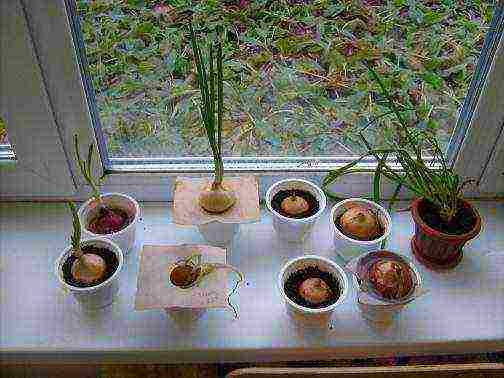
Performers: Grade 3 students
and teacher
• Project type - creative, collective, short-term.
• Performers - grade 3 students and a teacher.
• Nature of the project - educational research work.
• Target: grow green onions, get the research skill
Project objectives:
ü Arouse children's interest in project activities, since it makes it possible to:
Ø Show creativity in thinking
Ø Learn the elements of search work
Ø To learn how to search for information, its analysis, structuring.
Relevance of the topic: the subject-content area of the project united all the subjects studied in elementary school, their interdependent connections.
Practical focus of the project that every child has grown green onion feathers.
Structure - a block of theoretical knowledge, practical activity, experimental work.
The dominant activity in the project is educational and research, creative and search.
v Project stages
Long-term plan
1. Collecting information about onions, riddles and poems about onions, planting and growing onions in various conditions.
2. Learning poems about onions, talking about ways to grow onions.
3. Composing stories and tales about onions, riddles, observing changes in the plant, observing onion growth and recording observations in journals, completing experimental activities.
Topic: Planting Onions
Program content: to expand children's knowledge about the beneficial properties of onions; consolidate knowledge about the conditions for growing plants; develop curiosity, bring up responsibility for the assigned task.
Material: onions for each child, containers for planting onions for each child (plastic cups); earth, a kettle with water, small spatulas (for those who will plant onions in the ground, halves of notebooks, scissors, simple pencils for each child;
- I suggest you turn into real scientists and conduct an experiment on growing onions in various conditions. You will grow onions in the dark, cold, warm, and under normal conditions on a windowsill. Some guys will grow onions in the water, others in the ground. Before starting work, think about the conditions in which each of you would like to grow your bulb, and divide into teams. One team should include those who want to grow onions in the dark, in the other, those who will grow onions in the warmth, etc. In each team, the guys will grow onions both in water and in the ground.
Children are divided into teams on their own. The teacher distributes to each child an onion, cups, pots of soil, scissors, pencils, half of a notebook. Within the teams, children decide which of them will grow onions in the ground and who in the water. Then, with the help of scissors, they cut the bulbs upwards, in order for the sprouts to appear faster, pour water into cups or plant the bulb in the ground and water it. After planting the onions, the guys make the inscription "Scientific journal" on their notebooks and write their first and last name. Then, in the notebooks themselves, they write down the date of planting the onions, and in what conditions they are grown. For those who find it difficult, the teacher writes on the board.
For example:
15.10 Planting a bow. We grow in the dark (warm, cold, under normal conditions).
They poured the onion.
23.10 A sprout appeared.
In the future, each child independently takes care of his plant, watering it and making appropriate notes and sketches in his scientific journal.
Topic: "Useful properties of onions"
Program content: to acquaint with the beneficial properties of onions, methods of using them in the treatment of various diseases, develop creativity when showing a scene, instill interest in information about onions.
Scene "The bow is my friend"
Doctor's advice "Onion for seven ailments"
Books - babies about onions (poems, riddles, proverbs)
PROJECT PRESENTATION

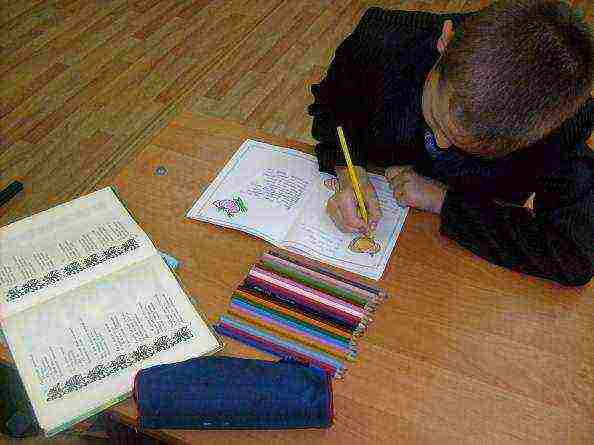

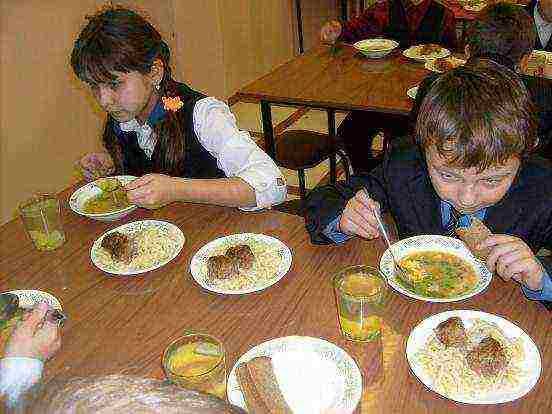
Delicious green onions!
Topic: "Three brothers onion"
Program content: to acquaint children with the stages of onion growing; give an idea of the different varieties of onions; consolidate knowledge about the beneficial properties of the vegetable; instill an interest in a healthy lifestyle.
Material: onion seeds; sets of white, yellow and red; onion heads of red, white and yellow; a picture of a flowering onion, sheets of paper for each child, pencils or paints.
Fairy tale "Three brothers".
“The boy Ilyushka was at the dacha. He sat on a bench and dangled his leg.Suddenly three boys ran up to Ilyushka: one - small and black, the other - bigger, in a golden suit, and the third - the largest, ruddy and strong, in golden armor with a large green onion in his hands.
- Chernushka onion, Sevok onion, Onion Onion, - they bowed in turn to Ilyushka and said:
- We are all brothers, we came to check if everything is all right with you. After all, we, bows, are famous defenders, like our brother Garlic.
- Who are you protecting? The boy asked.
“Everyone: vegetables from pests, people from microbes, a home from troubles and diseases,” onions answered proudly.
- What good fellows you are, I would also like to be such a brave defender.
- It's very simple: you just need to take care of those who are next to you, - explained the little onion Chernushka, - I, for example, the smallest, simple onion seed, but without me our middle brother - the onion Sevok will not grow. They put me in a garden bed, and I immediately begin to grow a golden suit and green feathers for him. So that everyone can see that my feathers are ready to help anyone, I bend my very first stalk in the form of a bow. "
“Without me, our elder brother, Onions, will never grow,” said onion Sevok. - As soon as they put me in the ground in the spring, I begin to make copper armor for my copper brother: I grow many, many scales and large succulent feathers in the bulb for him. My green feathers in the spring are the first to save a person from vitamin deficiency! "
“I, everything that my younger brothers gave me, must give to people and to my brothers for their care with good repay,” said the Onion. “In each scale I have thousands of volatile volatile warriors. As soon as I see that harmful microbes are preparing to attack someone, I immediately release my soldiers. They drive all microbes away without looking back. Eat me more often, Ilyusha, and not a single harmful microbe will touch you. "
“- How do you return goodness to your brothers? - Ilyushka asked.
- In order for our family not to stop, I release an arrow and grow a white spherical inflorescence on it. It is from him that my younger brothers grow - black seeds. But I do not always manage to raise my brothers in the first summer. If the summer is short, I don't have time to bloom. It happens 2-3 years pass before I can grow seeds.
“How friendly you are,” said Ilyushka with respect.
- There are three of us brothers in the genus of the Onion Onion, and in total there are about four hundred brothers-onions in the onion family, and they are all friends, the Onion Onion laughed "
Topic: "What happened to the bow in a month"
Program content: review and compare bows one month after planting; identify the difference in the appearance of onions grown in different conditions and the reasons for this; fix the structure of the plant; develop curiosity, creative imagination.
Material: onions grown by children for a month; bulb; sheets of paper for each child, colored paper, glue, scissors, napkins.
1. The structure of the bow.
Distribution into groups according to onion growing conditions.
Look at the bulb in my hands and your bulbs, are there any differences among them, what are they? (roots appeared, onion arrows grew, the bulb itself became softer)
2. Comparison of plants grown under different conditions.
Children take turns looking at onions grown in the dark, in the cold, in the warm, under normal conditions, and compare the appearance.
- Feathers of onions grown in the dark, pale, why (not enough light?)
- Onions growing in the cold gave still small shoots, onion feathers are dark, but not high, why (there is not enough heat)
- Onions growing in the warmth (near the battery) are not the same: some bulbs practically did not sprout (there is not enough water, moisture evaporates quickly, the owners had to water more often, the green arrows of other bulbs withered (they were burned).
- The arrows of the onion growing on the windowsill are the highest and most powerful, bright green; all the bulbs gave shoots (all the conditions for growing plants are met, the plant receives enough light and heat, requires moderate watering).
-Summarizing.(Favorable conditions required for successful plant cultivation).
Experiment
1. Bow at the beginning of the project
1.a. warm-grown

1. b. cold-grown
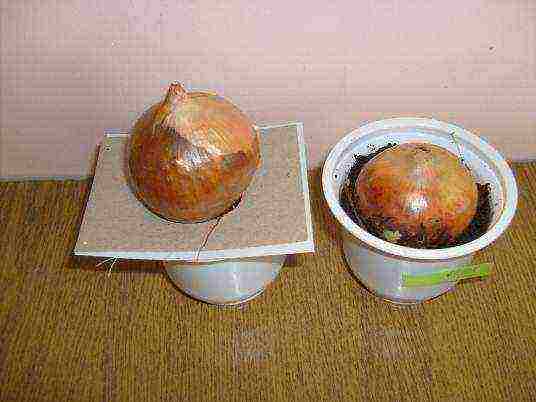
1. in. grown in the dark
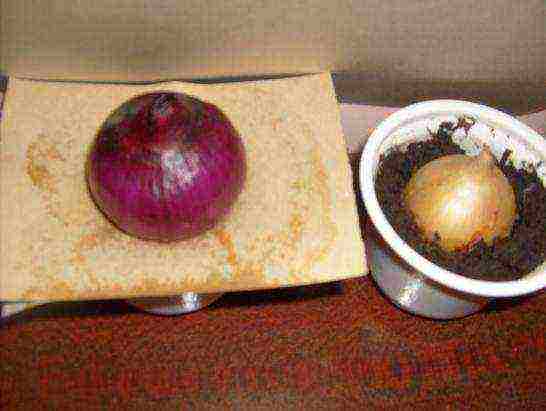
1.Growed under normal conditions
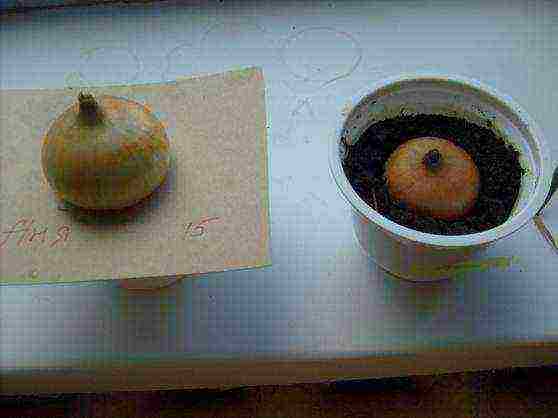
2. Onions in a month
2.a. warm-grown
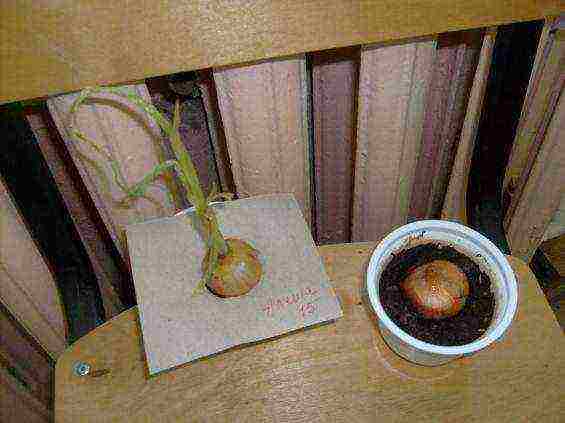
2. b. cold-grown
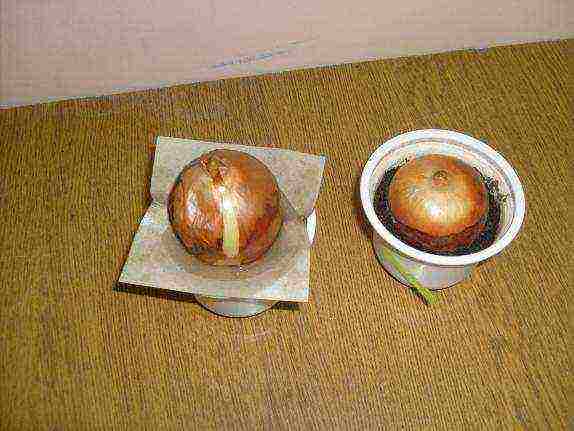
2.c. grown in the dark

2.Growed under normal conditions

See full lists: Professions
Text of this presentation
Slide 1
Research work "Growing onions on a feather in indoor conditions"
Prepared by Erokhina Ksenia, student of the 6th grade of MKOU Malyshevskaya secondary school
Slide 2
Objective: to study the effect of different soil on the growth and development of onions on a feather at home.
Slide 3
Tasks: 1. Choose a different soil for the experiment. 2. Assess the influence of different soil on the growth and development of onions. 3. Learn about the benefits of onions and their uses, cultural history. 4. Determine the necessary conditions and methods for growing onions on a feather. 5. Observe the growth of green onions. 6. Study the literature on this issue.
Slide 4

Hypothesis: I assume that soil and sand are the most optimal for plant growth
Research object: vegetable - onion
Subject of research: the influence of different soil on the growth of a plant.
Research method: experiment, observation
Slide 5

They began to grow onions 4 thousand years before our era. The ancient Greeks revered onions as a plant that brought health. In Europe, onions were originally used as a seasoning, then they became indispensable for daily nutrition. The most important part of the plant is the bulb. It contains many vitamins necessary for human health. Especially a lot of vitamin C in green onion leaves, which are often eaten raw.
Slide 6
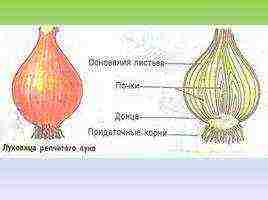
Slide 7
For the experiment, plastic containers of equal volume and bulbs of approximately the same size were prepared.
Slide 8
Slide 9
I numbered the pots: under number 1 - soil; No. 2 - sand and No. 3 - clay.
Slide 10
Observations and measurements were carried out for 24 days.
Slide 11
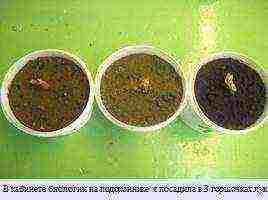
In the biology office, on the windowsill, I planted onions in 3 pots.
Slide 12
I planted onions on November 13. Every day I watched, irrigated the soil as needed, made notes of observation.
Slide 13
Slide 14

5 days after planting, the onion sprouted in the sand. After 7 days - in the soil. But it didn’t grow in the clay.
Slide 15
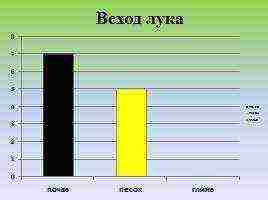
Slide 16
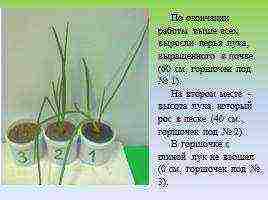
At the end of the work, the feathers of onions grown in the soil rose above all. (60 cm, pot number 1). In second place is the height of an onion that grew in the sand (40 cm, pot number 2). In a pot of clay, the onion did not rise (0 cm, pot number 3).
Slide 17
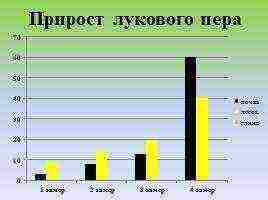
Onion Feather Growth
Slide 18
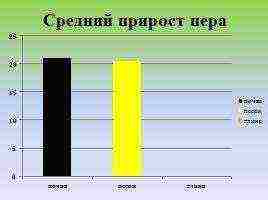
Slide 19

Thank you for your attention!

